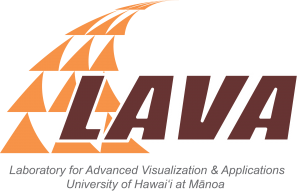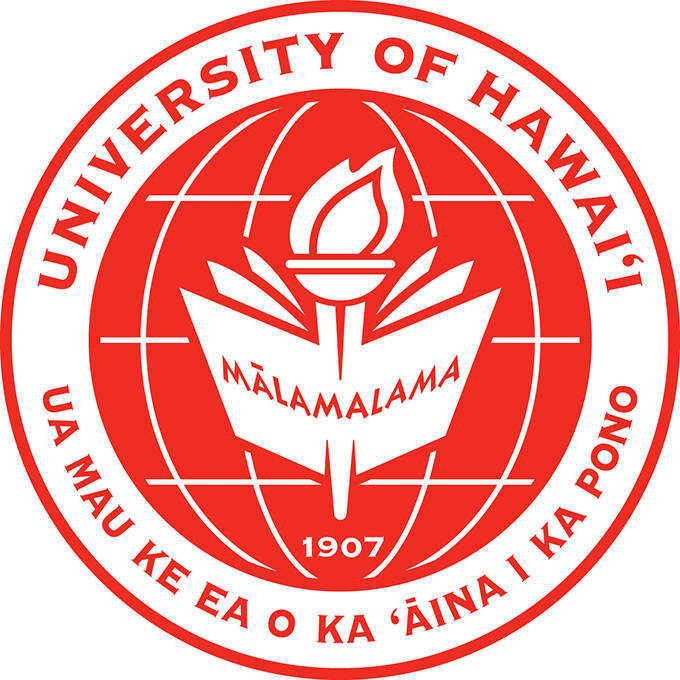
University of Hawaiʻi Facilities, Equipment and Other Resources
Shared Cyberinfrastructure University of Hawaiʻi Information Technology Center Building 
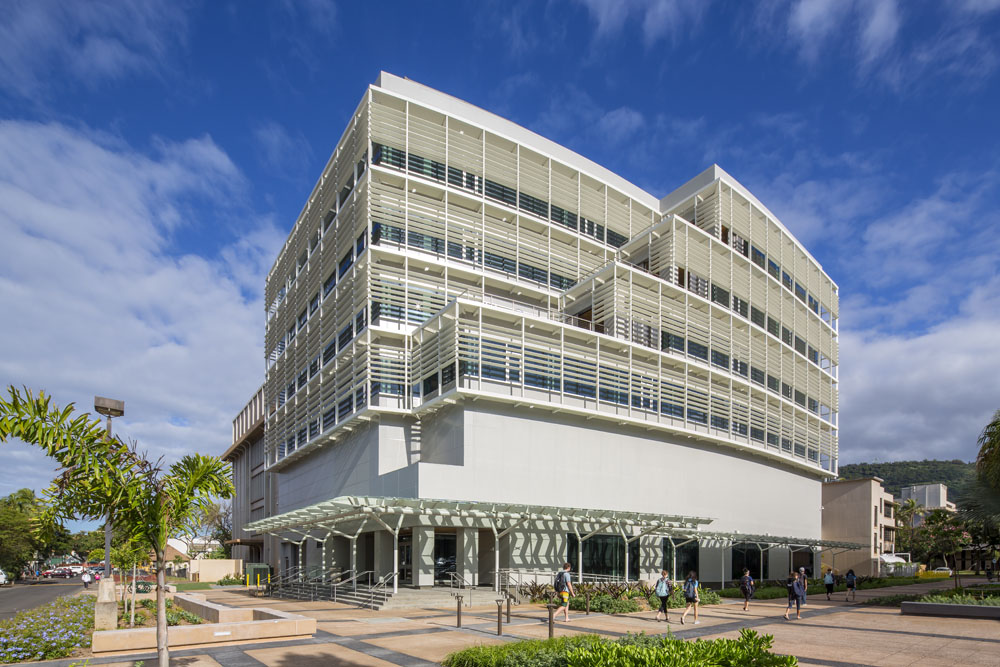
The Information Technology Center (ITS) houses enterprise information and communications technology systems and services that support modern teaching, administration, and research for all ten University of Hawaiʻi (UH) campuses throughout the state of Hawaiʻi. The building features an energy-efficient disaster-hardened, 8,000-square-foot data center for enterprise servers, research computing, storage, and communications, high-quality space for faculty to develop digital content, and meeting and training rooms with teleconferencing capabilities. The sustainable building design meets LEED Gold certification standards and houses the UH ITS support staff.
Campus, Statewide, National, and International Networking
The UH GigaPOP provides connectivity to national and international Research and Education networks for the entire state of Hawaiʻi. UH has a number of high-speed circuits connecting it to the global Research and Education network fabric. The University has two 10Gbps circuits that connect Hawai’i to the Pacific Northwest GigaPOP (PNWGP) in Seattle and to the Corporation for Education Network Initiatives in California (CENIC) in Los Angeles. Additionally, the University has two 100Gbps circuits that connect Hawai’i to PacificWave (PWAVE) in Los Angeles and the Guam Open Research eXchange (GOREX) in Guam. Finally, as part of an NSF IRNC grant (OAC – 1451058), the University has two 100Gbps peering connections to the Australian Advanced Research Network (AARNet) on Oʻahu and the Island of Hawai’i that connects the state of Hawai’i with Australia and the US West Coast. The University’s statewide network is composed of 40G and 80G links between the islands and 10G and 100G links between sites on-island. The University’s statewide network connects all public higher education sites in Hawaiʻi.

Current Campus Network Topology 
The UH Mānoa campus network is composed of 1Gbps and 10Gbps connections from the core to the fiber distribution hubs and from the distribution hubs to almost all of the campus buildings. The campus network core, along with the GigaPOP, is housed in the UH ITS data center alongside the UH IT operations center, which serves as a consolidated network operations center (NOC) and monitoring center for systems and services. With funding from the NSF Campus Research Cyberinfrastructure – Network Infrastructure and Engineering (CCNIE) program (NSF ACI#1340968) the campus network has been upgraded to 10Gbps for all major science buildings connecting to the UH Data Center. A Science DMZ and perfSONAR monitoring tools ensure friction-free data transfers both on and off campus and unimpeded access to data stores and HPC resources. The campus network provides IPv4 and IPv6 connectivity to every building and room within the campus and IPv6 is fully supported on the wide area as well.
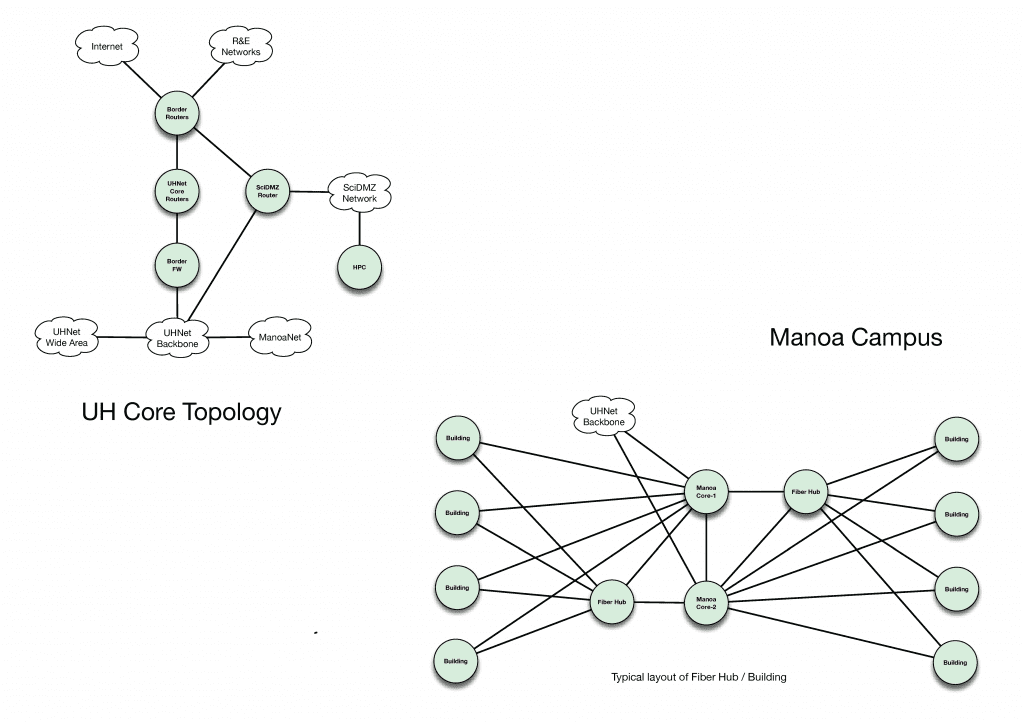
Campus Data Center 
The UH ITS data center was certified LEED NC v2.2 GOLD by the US Green Building Council in 2015, one of only a handful of LEED-certified data centers in the United States. The facility consumes 22% less energy than a code-compliant conventional building, a remarkable achievement for a data center. The 8,000 square-foot, state-of-the-art facility with advanced power, cooling, and disaster avoidance features hosts all of the UH enterprise information and communication technology systems serving all 10 UH campuses throughout the state of Hawaiʻi.
Research Computing Facility 
The UH ITS Research Cyberinfrastructure team (UH RCI) manages and maintains an HPC cluster “Koa” that is available to all UH System faculty, staff, and students for free. Koa has currently completed a large upgrade in order to integrate compute(Koa) and storage(KoaStore) purchased with two recent NSF CC* awards (#2201428, #2232862). The Koa infrastructure consists of 7904 cores across 275 nodes including 22 GPU nodes with a total of 148 GPUs hosted in the UH-ITS data center. The tables below summarize the diverse nodes that comprise Koa. The 275 Koa nodes are heterogeneous regarding network connections; all nodes are 1GbE connected; 7 nodes are 25GbE connected; and the most recently acquired 76 nodes are HDR100 infiniband and 25 GbE connected. All nodes are managed by the 1GbE connection to the management infrastructure.

Koa has login and management services are provided by two VMWare servers, two redundant firewall machines, 144TB Vhost network-attached storage (NAS), 1.0PB user NAS, 61TB Cray ClusterStor E1000 flash storage for scratch, HDR Infiniband networking, and 100 GigE switching.Koa virtual machines (VMs) that manage the compute nodes with the open source xCAT software, provide login node VMs, data transfer VMs, and other management services VMs. Open OnDemand is a web-based HPC environment that is available in addition to traditional ssh access to Koa.
Jetstream 2 NSF Cloud 
UH is also a regional Jetstream 2 host site housing Jetstream 2 NSF cloud computing services. Jetstream 2’s signature innovation is its ability to make high-performance computing and software easy to use by researchers who have limited experience with supercomputing systems. The project team also has a goal of serving more students than any other NSF-funded CI resource, leading to a diverse pool of graduates entering the STEM workforce with robust training in computational science. The regional UH deployment of Jetstream 2 has 8 compute nodes that deliver 1,024 cores, 4TB or RAM, 869T of Storage. It also has 2 accelerator nodes that provide 1TB of RAM and 8 Nvidia A100 GPUs.
Data Storage 

The UH ITS Data Center houses research data and computational assets for scientists throughout the UH System. Koa provides 6 PBs of Lustre storage which can be accessed on Koa or through a nextcloud web service (KoaCloud) for research labs and collaborative storage (similar to dropbox).
Science Gateway and API Infrastructure 
UH CI provides a rich scientific research API middleware infrastructure layer, built on the Tapis Framework (OAC 1931575, 1931439) locally deployed at UH. This cyberinfrastructure offers an HTTP API that provides fine-grained access to the authentication, data management, compute, and storage infrastructure maintained by UH CI. Additionally, a web-based gateway offers UH researchers access to the UH Tapis API services in a browser interface.
Laboratory for Advanced Visualization and Applications and Hawaiʻi Institute of Data Science 

The Laboratory for Advanced Visualization & Applications (LAVA) and the Hawai’i Data Science Institute (HI-DSI) share a joint space to encourage collaborations between domain scientists, computer scientists, engineers, artists, and their students. LAVA was founded on January 1, 2014, by Jason Leigh, who is director Emeritus of the Electronic Visualization Laboratory (EVL) at the University of Illinois at Chicago. LAVA conducts research and development in Big Data visualization techniques, and applies these techniques to cutting edge domain science, engineering, and training applications.
Figure 2: Visualization Systems at LAVA/HI-DSI and UH West Oahu
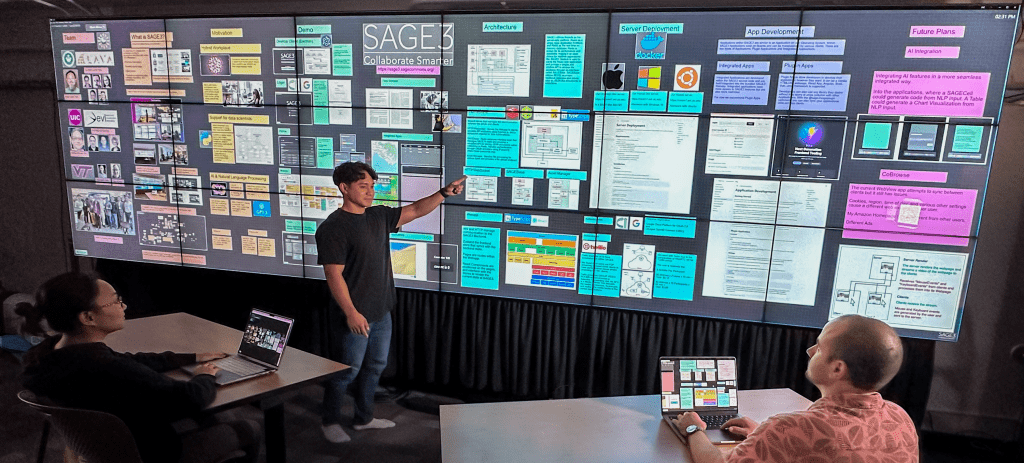

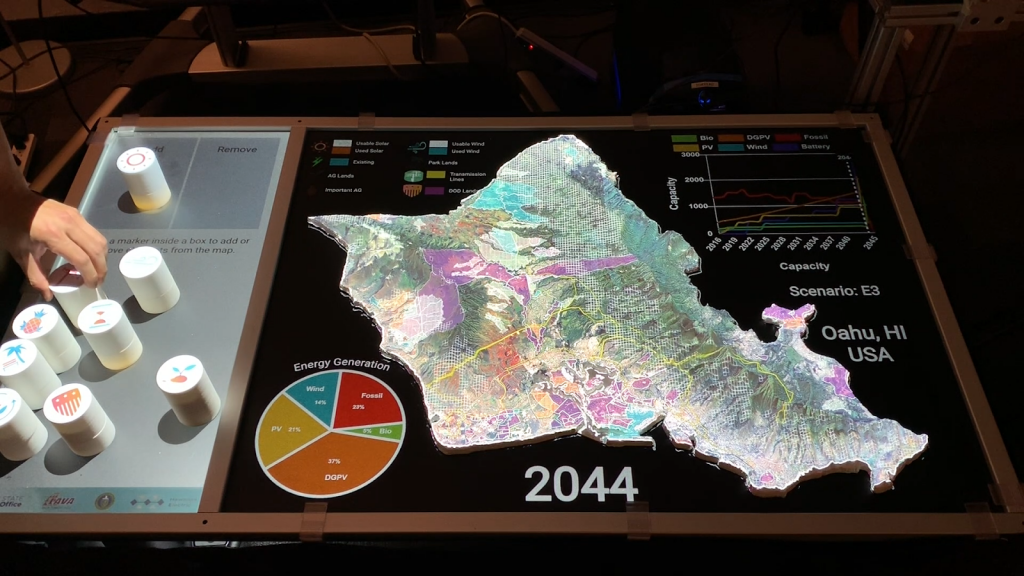

Jointly, LAVA and HI-DSI are equipped with a 24 Megapixel CyberCANOE (Cyber-enabled Collaboration Analysis Navigation and Observation Environment) [Figure 2- top left] capable of stereoscopic 3D imaging; a 256 Megapixel surround CyberCANOE also capable of 3D imaging [Figure 2- top right]; a 30 Megapixel CyberCANOE, and a fully seamless LED CyberCANOE; a ProjecTable tangible physicalization system [Figure 2- bottom left]. A total of 18 CyberCANOEs of varying capabilities have been deployed at several locations in Hawai’i, including the University of Hawai’i at West O‘ahu (UHWO), University of Hawai’i at Hilo, and Honolulu Community College (see Table below). These systems were primarily funded by a prior NSF MRI award (NSF CNS-1530873), to Dr. Leigh. The MRI provided strong leveraging, which enabled further deployment of CyberCANOEs in Hawai‘i funded by the Academy of Creative Media System (ACM), the Department of Energy, the Hawai’i State Energy Office, and the Bishop Foundation. In Fall 2021, LAVA also acquired a Modix 120X large format 3D printer for use in large scale data physicalization research.
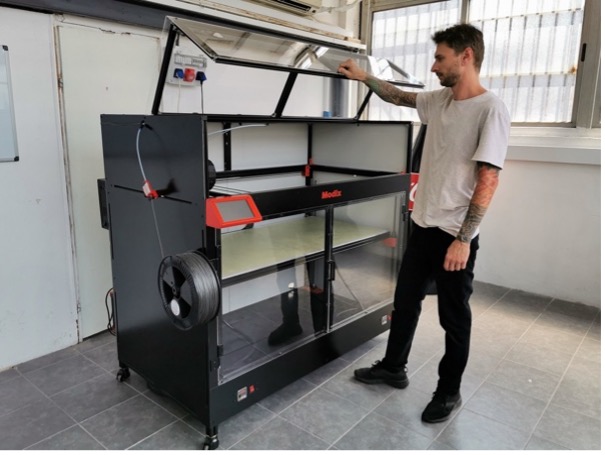
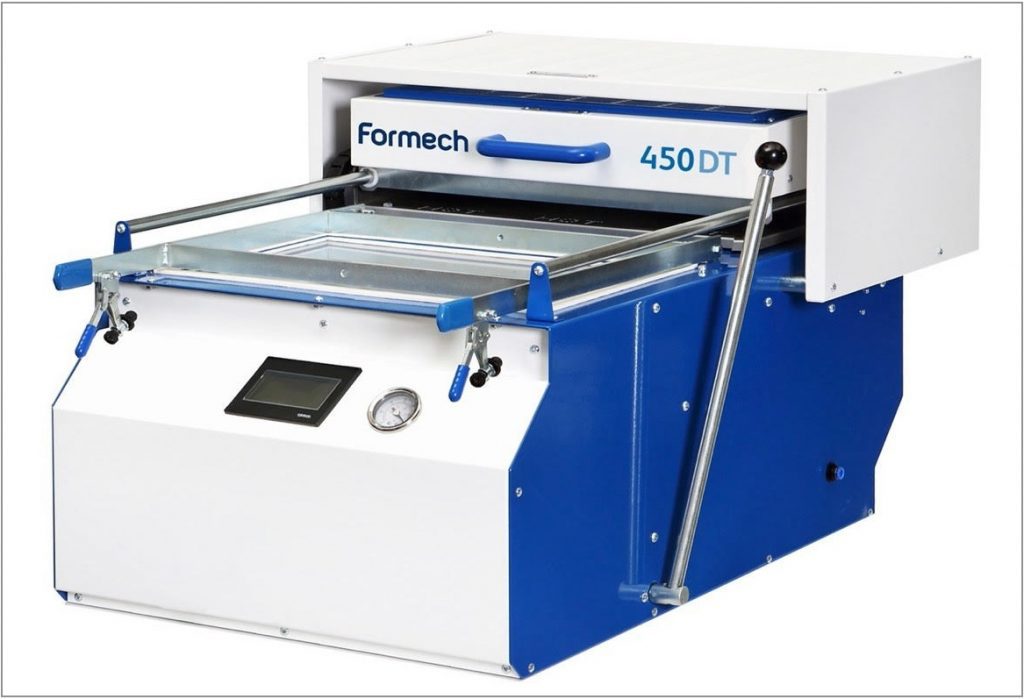

University of Hawaiʻi at Hilo 
Spatial Data Analysis and Visualization Lab (SDAV)
SDAV possesses a dedicated Server Complex, a Synology DS1819+ 8-Bay DiskStation with 8GB RAM and 96TB (8x12TB) of Seagate Ironwolf NAS DRIVES.
Workstation PCs include: (7) Research PCs from AVADirect Custom Computers, including one with a Titan RTX GPU with 24 GB of memory for machine learning applications; (25) Teaching PCs: (13) HP Workstation Z230s – MT – Core i7 4790 3.6 GHz – 8 GB – 0.5 TB; (12) CyberpowerPC Desktop Computer Gamer Xtreme S307TLQ Intel Core i7 7th Gen, 7700K (4.2 GHz) 16 GB DDR4 3 TB HDD 512, GB SSD Windows 10 Home 64bitGPS capabilities include: One (1) Applanix POS AVX 210 GNSS-Inertial solution integrated into a custom aerial mapping system, Four (4) Trimble R10 receivers, Three (3) GeoXH GeoExplorer 6000 Series –dGPS; One (1) Trimble GeoXT – dGPS plus field accessories; One (1) Trimble Nomad -dGPS plus accessories; One (1) Leica GS20 WoRCS-RBT Mapping System – dGPS; One (1) Leica Laser Locator Binoculars w/GIS package; Thirteen (13) Garmin Rino 655t with walkie talkie & built-in camera; One (1) Garmin GPSMap 60C; Fourteen (14) Garmin GPSMap76S; Two (2) Garmin Rino 130; Plus waterproof bags for GPS.
Additional equipment includes a Trimble SX10 laser scanner, DJI M600 and M200 small unmanned aerial systems with an assortment of cameras and sensors, including thermal and multispectral cameras, a Headwall Nano Hyperspec hyperspectral sensor, a helicopter-mounted aerial mapping system, and two (2) 4WD research vehicles.
Software available includes ArcGIS and Arc Pro, 50 licenses; ArcGIS Lab Kit, 31 floating licenses; MATLAB, 25 licenses; ENVI+IDL, 25 licenses; lastools, campus licenses; Origin Lab Data Analysis and Graphing, 1 license; ProShow Producer Professional, 5 licenses; Socet Set v5.5 & Socet GPX v3.2, 1 licenses; TerraGo Publisher & TerraGo Composer, 5 licenses; Xtools Pro 7.x, 50 licenses; MS Office (all PC & Mac workstations); Adobe Acrobat Professional, 5 licenses; Adobe Photoshop Elements, 12 licenses; Adobe Creative Suite Design Premium 5.5, 6 licenses. GPS Software includes Trimble Business Center, Trimble Educators Pack (2 licenses): Trimble TerraSync; Trimble GPS Correct; Trimble GPS Analyst; Trimble Pathfinder Office; Leica GIS DataPro.
Data Science Classrooms
Data Science at UH Hilo has several spaces on campus used for various research and data science instructional activities.
1. Edwin Mookini Library (LRC 350) LRC 350 is a sound-insulated, 800 ft2 , 25-ft ceiling local TV studio that was converted into a dedicated data science classroom and laboratory. It is equipped with a destiny-class CyberCANOE in 3×3 clustered screen configuration (165” total diagonal size), driven by a high performance computer as a central focal point. The system running this is an Alienware Area-51 Desktop with an i7-6900K, 32GB DDR4, and three AMD RX 480s driving the display wall. Facing it are 22 Mac Minis (i5, 4GB RAM) set up to dual boot in MacOS or Windows. Installed software includes Microsoft Office, R, RStudio, Anaconda, Internet Browsers, SAGE2 plug-in. Students or participants can collaboratively interact with the CyberCANOE via the 22 workstations or a personal laptop. Peripherals include an HTC Vive for virtual reality support, high fidelity sound system and video conferencing system to extend the functionality of the CyberCANOE. LRC 350 is used for Data Science instruction and research.
2. College Hall 5 (345A-5), Computer Science Data Vis Laboratory The Data Vis laboratory has 24 MSI desktop workstations (21x i7-7700K, 16GB DDR4, Nvidia GTX 1060 and 3x i7-8700K, 16GB DDR4, Nvidia GTX 2070) and a 1×3 configuration CyberCANOE. The CyberCANOE has three 86” screens positioned horizontally and driven by an Alienware Area 51, (i7-6900K, 32GB DDR4, Nvidia GTX 980 Ti). This lab also has video conferencing equipment to support distance and remote collaboration. The installed workstation software includes MS Office, R, R Studio, Anaconda, Visual Studio, Python, CLion, Unreal, Unity, and Notepad++. This lab has been used for various EPSCoR Ike Wai summer research activities. (
3. College Hall 11 (345A-11A), Computer Science Classroom The computer science classroom has been retrofitted to support Data Science instruction. It features 23 Dell Precision (i5-7500, 8GB DDR4, AMD FirePro W4100) workstations, and has R, R RStudio, MS Office, Visual Studio, Clion, and Anaconda installed. The classroom has a mini SAGE2 wall that supports remote instruction and collaboration. Video conferencing equipment has been added to make it usable for COVID-19 instruction. The classroom has been used to teach courses under data science. Other Resources: Repurposed DS GPU Server: (Xeon X5680, 24GB DDR3, Nvidia GTX 1070; Running Linux Mint) Server is used for Data Science instruction and research.
Chaminade University of Honolulu – Facilities and Other Equipment 
Institutional Resources for Student Success
Chaminade University of Honolulu (CUH) is a Federally designated NativeHawaiian-serving 1200-student institution with a unique mission of serving underprivileged students in Hawai‘i and the Pacific, particularly indigenous communities. CUH is 42% Native Hawaiian Pacific Island (NHPI), 69% first generation, 69% low income, 49% maximum Pell-eligible. In AY 2018 CUH had a 90.6% first to second year retention rate for NH, a 69% overall 6 year graduation rate and NH are the highest graduating and most retained population of our students. CUH is in the 92nd percentile nationally for income mobility. CUH has undergone a decade-long transformation in STEM under the leadership of PI Turner. In 2007, CUH had 0 sq. ft of research space, primarily Master’s qualified faculty, no advanced instrumentation, labs that had not been renovated since the 1950s, virtually no grant funding and had published only a handful of peer-reviewed science papers since 1955, and poor student completion rates (e.g. at that time 43% of Biology majors dropped out between the 1st and 2nd semester). Today, the picture is substantially different. Powered by broad based Federal funding, foundation and donor commitment to our mission, CUH completed a ~$20M lab renovation, including research spaces, new microbiome and advanced instrumentation teaching labs (2019), a $3M advanced instrument facility, a new 2000 sq. ft. Data Science Center and a cultural gathering place for STEM students (Kipuka Center). CUH mitigates NHPI financial barriers to access and success with a $21M NH STEM scholarship program (Ho`oulu, see below) and 2 $1M NSF S-STEM scholarship programs. Since 2007, CUH successfully recruited R1 faculty with active research programs (NIH, NSF, DoD, NIJ) and teacher-scholar vocations, doubled the size of the STEM faculty and have 100% PhD faculty in CUH served majors. Since 2007, CUH added four new STEM majors, doubled the number of STEM students and increased NHPI STEM enrollment to >50% of the incoming class. Currently, CUH has ~270 declared STEM majors: 61% are URM and within this number over 30% are NHPI, of whom almost 45% are of NHPI descent. A full 79% of CUH STEM majors are women. Moreover, 30% of CUH STEM majors have a zero dollar FAFSA Expected Family Contribution (EFC), 50% of CUH STEM majors are Pell-eligible, and 97% receive financial aid. CUH is now a Howard Hughes Medical Institute ‘Inclusive Excellence’ institution, and over the last decade the portfolio of funded programs (NIH BRIC, R15, R01, NSF AISLDRL-211691, NSF CAREER CHE-1752607, I-USE, INCLUDES, S-STEM, etc.,) has exceeded $50M. Students benefit from fully funded research internships at US mainland R1 and industry sites (>300 internships in the last 7 years), conference presentations (>400 in the last 7 years, with 14 national research prize winners), professional tutoring and PLTL support for gatekeeper courses and course crisis management, and a robust ‘Academic Navigator’ program where NH faculty (Naeole, Cogbill, co-PI Chong) act as life- and academic-coaches.
Data Science Facilities
The university’s data science and analytics program is staffed by 4 full time and two part time faculty and housed in a 2000 sq. ft purpose-renovated (2019) Data Science Center (DSC). The DSC comprises:
· 4 faculty offices (120 sq. ft each) equipped with MAC/PC desktop and laptop, printer, dedicated 200MBS network connection.
· A 24-student data training area with 2 CyberCANOESs. We implemented the CyberCANOE model pioneered by Dr. Jason Leigh (Laboratory of Advanced Visualization and Analytics, University of Hawaiʻi, NSF ACI-1441963, CNS-1530873). SAGE2 comprises cloud-based and web-browser technologies to provide a framework for groups of students and researchers, whether in the room or remotely, to collaborate to solve problems that require viewing and controlling the display of large volumes of information in ultra high-resolution. The classroom area has 45 sq. ft Ultra 4K display (82 Megapixels), with SAGE2 running on 2 Dell Area 51 computers with I7-6950X (10 core) CPU, two NVIDA GeForce GTX 1080Ti display cards, each with 11 GB of GDDR5X graphic RAM memory.
· Two Virtual Reality (VR) suites.
· A 3D printer for producing data visualization and physicalizations (Monoprice Delta PRO 3D Printer with (270 x 300 mm) Heated Glass Build Plate, Auto Leveling, Triple Fan, PID Tuning).
· Several mobile data visualization 4K screens with touch screen capability.
· Two large data wall tiled displays (Shark, Manta): High resolution 4K OLED tiled displays totaling 382 Megapixels with accompanying storage, memory and processing capability. Total GPU capabilities: 18432 CUDA Cores; 2304 Tensor Cores; 288 RT Cores; 56.8 TFLOPS Single-Precision Performance, 456 TFLOPS Tensor Performance. Shark is flat-wall, Manta is angled for data immersion.
· Total GPU capabilities: 18432 CUDA Cores; 2304 Tensor Cores; 288 RT Cores; and produces 56.8 TFLOPS of Single-Precision Performance and 456 TFLOPS of Tensor Performance.
· Collaboration space.
· Café/Lounge space

The tiled displays are the nucleus of a decision support and collaboration space with multiple work nodes. Data Science students and faculty work on client- and community-supplied use cases and problem sets, and specific faculty research interests include Cybersecurity/Human Factors, biologically-inspired data visualization for rapid decision-making, network analysis of microbiome-host interactions, technology adoption models in healthcare and in silico design of metagenomic solutions for pollutant remediation. The DSC provides R, R Studio, MS Office, Jupyter Notebooks, Tableau, DataCamp, Anaconda to faculty and students.
United Nations CIFAL Center Data Analytics Research Team (DART)
A 1700sq ft state of the art data science research collaboration space.
NSF ALL-SPICE Alliance at Chaminade (HRD-2217242) 
A $10M program supporting the building of inclusive data science capacity across Hawai’i and the Pacific region. Nine faculty, postdoctoral and graduate analysts supporting ~50 undergraduate research experiences/YR , faculty in residence program. Workforce development programs (K-community, social sector, veteran, ROTC and working professional upskilling in DS).




